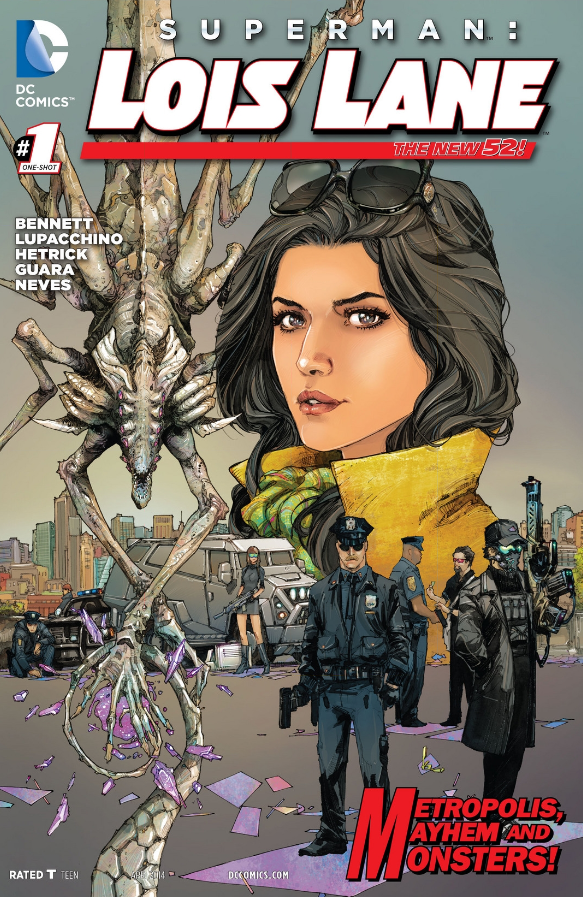Odds are, if you’ve heard of Superman, you’ve also heard of Lois Lane. Lois has been a part of the Superman franchise since its creation, making her first appearance with Superman himself in the first issue of “Action Comics” 75 years ago. She has since appeared in its various films, TV shows, and, of course, comic book series. Lois proved so popular that she was given her own backup feature in “Action Comics” titled “Lois Lane: Girl Reporter” in the ’40s, an entirely Lois-focused issue of “Showcase” in the ’50s, and finally, her own ongoing comic book series entitled “Superman’s Girl Friend, Lois Lane” that ran from 1958 until 1974, lasting for 137 individual issues and 2 annuals. “Superman’s Girl Friend, Lois Lane,” in particular, is noted as having been so popular that it outsold then-current issues of “Batman.”
Unlike other love interests introduced at the same time, Lois was, and still is, more than her prescribed role. Even in her very first appearance, Lois is not defined by her love of Superman, but by her role as a hard-hitting, renowned journalist, which back then was a job reserved almost entirely for men. She was a game-changer for depictions of women in comics. It is arguably because of Lois that we live in a time when it is possible to have so many comics fronted by woman superheroes, when Marvel is able to publish a series titled “X-Men” about a team composed entirely of women, and when the latest issue of DC Comics’ “Harley Quinn” can sell more copies than “Justice League.”
Yet the influence and importance of Lois Lane and DC Comics’ other iconic woman characters has been belittled and ignored in recent years. With the company’s line-wide reboot in 2011 dubbed “The New 52,” DC Comics has controversially erased and modified the histories of some of its most prominent female characters, including Lois, Wonder Woman, Batgirl, and many more, while its prominent male heroes have remained mostly unchanged. Notably, in the press leading up to the reboot, Lois was described by DC as merely Superman’s “trophy wife,” ignoring her decades’ worth of contributions to the Superman mythos. When “The New 52” finally came, Lois’s marriage to Superman was erased, and she was controversially replaced as his love interest by Wonder Woman. Since then, Lois has been sidelined, playing a less significant role in Superman’s life than ever before.
This is why the new “Superman: Lois Lane” one-shot is so important. For the first time since “The New 52” began, Lois gets a chance in the spotlight. Though the issue is flawed in some ways, “Superman: Lois Lane,” from the creative team of writer Marguerite Bennett and a slew of different artists, is a welcome addition to the history of one of DC Comics’ most enduring characters.
Bennett is still a newcomer to the comic book industry, but it certainly doesn’t show in this issue. The main plot of the story concerns Lois’s investigation into the kidnapping of her sister’s roommate and the presence of a dangerous new drug on the streets of Metropolis. Bennett uses the main plot as a way to explore Lois’s relationship with her sister, to reveal some previously unknown details about Lois’s history, and, of course, to demonstrate Lois’s keen investigative skills. The plot is engrossing, and the story successfully covers a lot of ground without any of it feeling truncated or rushed.
Bennett’s Lois is thankfully reminiscent of her depictions prior to “The New 52.” Her indomitable spirit is fully present, and at no point does Lois stay out of the action. Bennett’s Lois does not rely on Superman to get her out of danger. She is capable of rescuing herself and only calls Superman when it is absolutely necessary. I am pleased to say that Superman, though in the title of this one-shot, shows up in only one of its panels, and at the end of the issue, Lois is the one who saves the day. As a way to showcase one of comics’ most iconic characters, this issue’s plot and script certainly work.
The art for this issue, however, is another matter. Originally advertised as having art from Emanuela Lupacchino, this issue is also credited to Meghan Hetrick, Ig Guara, and Diogenes Neves on pencils and Hetrick, Guillermo Ortego, Ruy Jose, and Marc Deering on inks. Thankfully, the only credited colorist is Hi-Fi. Considering this issue’s status as a standalone one-shot, I’m curious as to why DC didn’t just delay it until Lupacchino was able to finish her pencils.
All of the artists do a suitable job illustrating the story. Lupacchino, though, is the only one who really stands out. Her characters are vibrant, expressive, and fluid, accentuated by bold lines. They bristle with personality and energy. However, if there’s a real star artist of the issue, it is certainly Hi-Fi. When there are so many artists contributing, it is hard for an issue to have a consistent look. Hi-Fi does its best to grant the book consistent colors, easing the transition between artists. Despite Hi-Fi’s best efforts, however, the shifting styles still detract from the overall book, especially when considering the fact that—except when it switches to Neves, who only illustrates the flashbacks—the changes come without warning. Though no artist is necessarily weak, the art for “Superman: Lois Lane” is not a high point of the issue.
Whether DC Comics wants to admit it or not, Lois Lane resonates with readers; Lois Lane endures. With “Superman: Lois Lane,” Bennett and her team of artists have proven yet again that Lois can be the star in her own story and that that story can be interesting. Hopefully, this comic is a sign of much more to come with Lois.

Comments are closed